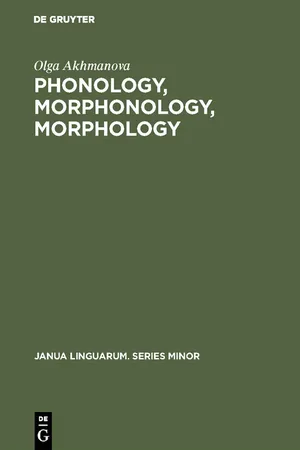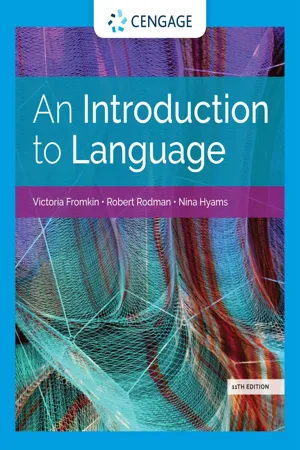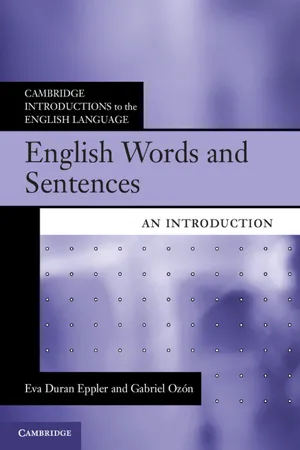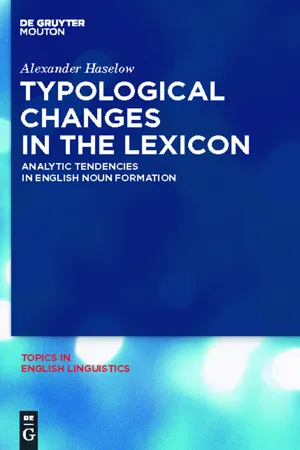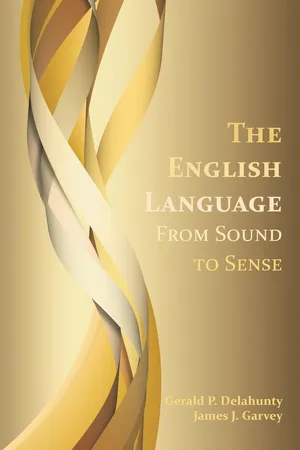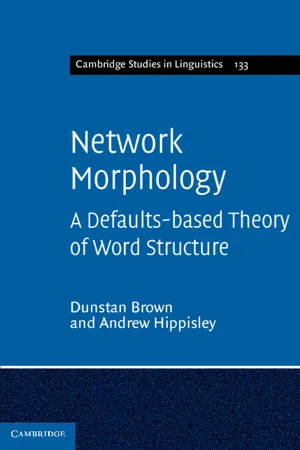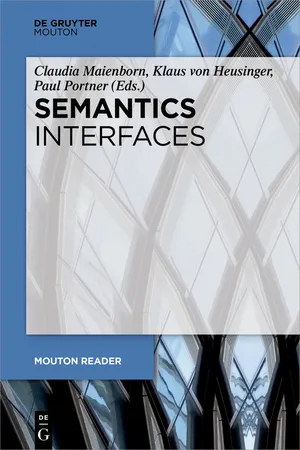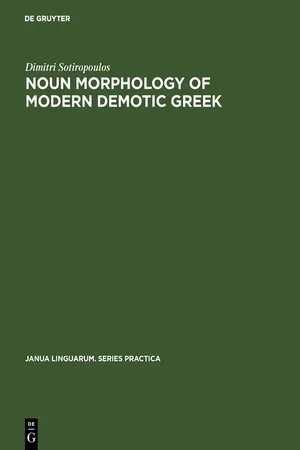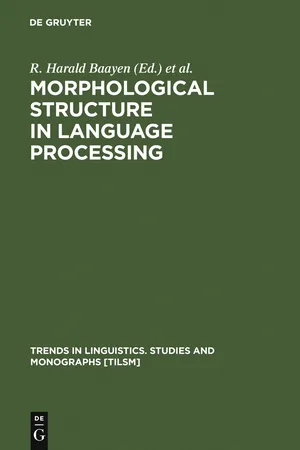Languages & Linguistics
Derivational Morphemes
Derivational morphemes are affixes added to a base word to create a new word with a different meaning or grammatical category. They can change the part of speech, such as turning a noun into a verb, or alter the meaning of the base word. For example, the suffix "-er" added to "teach" forms "teacher," changing the verb into a noun.
Written by Perlego with AI-assistance
Related key terms
1 of 5
11 Key excerpts on "Derivational Morphemes"
- eBook - PDF
- Olga Akhmanova(Author)
- 2018(Publication Date)
- De Gruyter Mouton(Publisher)
Taxonomies of this kind are 'ethno-centric' and are useless in the quest for linguistic universals. Of great interest are comparative-historical investigations which show that there are no distinct lines between derivation and inflexion from a diachronic point of view. In the history of language there are constant transitions from the former into the latter. (Very interesting illustrations are found in J. Kurytowicz, On the Meth-ods of Internal Reconstruction, Proc. of the 9th Intern. Congr. of Linguists, 17). 3.2.3 Inflectional Morphemes and Morphology in the Narrow Sense The 'lexical' (or 'root-', 'source-') morphemes are like words in many respects. They are endowed, to a greater or less degree, with the power of individual reference. They are often polyseman-tic, in a lexical sense. It is true, that Derivational Morphemes do not possess these qualities in the same marked degree, that many of them are on the border-line between lexical and grammatical morphology. Nevertheless (as will be shown later) it is not only possible, but also necessary to distinguish between derivational and inflexional morphemes as a matter of principle. A more detailed discussion of the field with its specific problems 102 MORPHOLOGY should be preceded by some metalinguistic clarification. First of all the term 'grammatical' which is a complex bundle of concepts : (1) expressing relationship; (2) systemic, standard, recurring; (3) auxiliary, concomitant in form. It follows that grammatical mor-phology deals with units (and processes?) (1) connected with the expression of relations between objects; (2) connected with rela-tions, expressed by means of regular, standard recurrent devices; and (3) auxiliary, concomitant subservient with respect to the 'material' (vescestvennoj) or 'lexical' part of words. The morphonological processes of lexical morphology are com-paratively speaking simple, even for most of the phenomena of derivation. - eBook - PDF
Word Knowledge and Word Usage
A Cross-Disciplinary Guide to the Mental Lexicon
- Vito Pirrelli, Ingo Plag, Wolfgang U. Dressler, Vito Pirrelli, Ingo Plag, Wolfgang U. Dressler(Authors)
- 2020(Publication Date)
- De Gruyter Mouton(Publisher)
Ingo Plag and Laura Winther Balling Derivational morphology: An integrative perspective on some fundamental questions Abstract: This chapter tries to answer some central questions in the study of derivational morphology: What are the units of analysis? What are the mecha-nisms that underlie the creation, as well as the syntagmatic and paradigmatic relationships, of derived words? For each of these questions we discuss a wide variety of approaches in different subdisciplines of linguistics (phonetic, theoreti-cal-linguistic, psycholinguistic, neurolinguistic and computational-linguistic), and see what evidence the diverse approaches have brought forward to support their ideas. Keywords: Derivational morphology, morpheme, Discriminative learning, Computational modeling, Evidence in morphology, Psycholinguistics, Priming 1 Introduction: What is derivational morphology? Derivational morphology (or ‘ derivation ’ for short) belongs to the realm of word-formation and is usually defined negatively as the kind of word-formation that is not compounding. Compounding is widely understood as the formation of words by concatenating two or more lexemes or bases. Thus, derivation is concerned with the ways in which morphologically complex lexemes are related to, or de-rived from, other lexemes by affixational or non-affixational means, but not by combination with other lexemes. This definition of derivation leaves us with a problem of demarcation be-tween compounding and derivation, which hinges on the question of what we understand by ‘ lexeme ’ or ‘ base ’ as against ‘ affix ’ . Additionally, since there is the basic distinction between word-formation and inflection, there is the prob-lem of demarcation of derivation (as part of word-formation) vis-à-vis inflec-tion. - Victoria Fromkin, Robert Rodman, Nina Hyams, , Victoria Fromkin, Robert Rodman, Nina Hyams(Authors)
- 2018(Publication Date)
- Cengage Learning EMEA(Publisher)
Languages such as Finnish and Japanese have a dazzling array of inflectional processes for conveying everything from “temporary state of being” (Finnish nouns) to “strong negative intention” (Japanese verbs). English spoken 1,000 years ago had considerably more inflectional morphology than Modern English, as we shall discuss in Chapter 8. The differences between inflectional and Derivational Morphemes in Modern English are summarized in the table below and in Figure 2.1 that follows it: Inflectional Derivational Grammatical function Lexical function No word class change May cause word class change Small or no meaning change Some meaning change Often required by rules of grammar Never required by rules of grammar Follow Derivational Morphemes in a word Precede inflectional morphemes in a word Productive Some productive, many nonproductive Copyright 2019 Cengage Learning. All Rights Reserved. May not be copied, scanned, or duplicated, in whole or in part. Due to electronic rights, some third party content may be suppressed from the eBook and/or eChapter(s). Editorial review has deemed that any suppressed content does not materially affect the overall learning experience. Cengage Learning reserves the right to remove additional content at any time if subsequent rights restrictions require it. Rules of Word Formation 49 The Hierarchical Structure of Words We saw earlier that morphemes are added in a fixed order. This order reflects the hierarchical structure of the word, entirely analogous to the hierarchical structure of sentences that we observed in the previous chapter. A word is not a simple sequence of morphemes just as a sentence is not a simple sequence of words. It has an internal structure. For example, the word unsystematic is com- posed of three morphemes: un-, system, and -atic. The root is system, a noun, to which we add the suffix -atic, resulting in an adjective, systematic.- eBook - PDF
English Words and Sentences
An Introduction
- Eva Duran Eppler, Gabriel Ozón(Authors)
- 2012(Publication Date)
- Cambridge University Press(Publisher)
Suffixes attach to the right of a root, base (or stem) and can either be derivational or inflectional. Inflectional morphemes act as syntactic glue in Chapter 3, section [3.7] 56 the construction of sentences. The following table provides you with brief definitions and examples of the most important concepts relating to mor- phology, the study of word forms. Name Definition Example Morpheme An abstract entity that expresses a single concept within a word function, dys- and -ed are morphemes Morph the concrete physical shape of a morpheme spoken or written function, dys- and -al Root the irreducible core of a word function is the root of dys-function-al Base any unit to which affixes can be attached dysfunction is a base Stem a root or base without inflectional affixes function without -s or -ing is a stem Free morpheme a root which can stand on its own function is a free morpheme Bound morpheme a morpheme which cannot stand on its own dys- and -al are bound morphemes Affix a bound morpheme which only occurs when attached to a root / free morpheme dys- and -al are affixes Prefix an affix attached to the left of a word dys- is a prefix Suffix an affix attached to the right of a word -al is a suffix Compounds words formed by adjoining two (or more) lexemes trouser press, mountain bike Key terms Morpheme; morph; root; base; stem; affix; prefix; suffix. Exercises Exercise 3.1 Activity 2.1 in the previous chapter was quite restrictive. We made the words played, beautiful, lovingly, bright, ran fit into the noun (NP) slot in the sentence How useful did ______________ seem to be? Derivational morphology 57 We are now in a position to be more creative. Rather than making the words fit the sentence, let’s build short grammatical English sentences around the words played, beautiful, lovingly, bright, ran. - eBook - PDF
Linguistic Fundamentals for Natural Language Processing
100 Essentials from Morphology and Syntax
- Emily M. Bender(Author)
- 2022(Publication Date)
- Springer(Publisher)
CHAPTER 2 Morphology: Introduction #7 Morphemes are the smallest meaningful units of language, usually consisting of a sequence of phones paired with concrete meaning. Morphology is the subfield oflinguistics concerned with the formation and internal structure of words. It encompasses morphotactics, or questions of which morphemes are allowed to combine within a word and in what order; morphophonology, how the form of morphemes is conditioned by other morphemes they combine with; and morphosyntax, how the morphemes in a word affect its combinatoric potential. 1 In all three cases, the units under consideration are morphemes, which can be defined as the smallest meaningful units oflanguage. A morpheme is typically a sequence of phones (sounds) paired with a concrete meaning. 2 A simple example is given in (6) where the boundaries between morphemes (with words) are indicated by'+': (6) Morpheme+s are the small+est mean+ing+ful unit+s oflanguage. This example, however, belies the actual complexity of morphological systems. As described be- low, both the 'form' and the 'meaning' part of the pairing can vary from the prototypes in impor- tant ways. Specifically, the form can be made up of phones which are not contiguous (#8), it can be made up of something other than phones (#9), it can in fact be null (#10), and finally the form can vary with the linguistic context (#23-#26). On the meaning side, in addition to core lexical meaning (#11), morphemes can convey changes to that meaning (#12) (which furthermore can be idiosyncratic (#13)) and/or syntactically or semantically relevant features (#14, #28-#43) #8 The phones making up a morpheme don't have to be contiguous. While prototypical morphemes are sequences of phones (sounds, represented by letters in alphabetic writing systems) which furthermore have easily identified boundaries between them, there are several ways in which morphemes can depart from this prototypical case. - eBook - PDF
Typological Changes in the Lexicon
Analytic Tendencies in English Noun Formation
- Alexander Haselow(Author)
- 2011(Publication Date)
- De Gruyter Mouton(Publisher)
Typical derivational processes are nominalizations, the formation of verbs and adjectives, or the indication of lexical categories like Diminutiv-ity. (1) and (2) are probably the most important criteria for the definition of a distinction between inflection and derivation: the marking of inflectional categories is obligatory, whereas marking derivational categories is a choice made by speakers for purely semantic reasons. Inflectional mor-phemes apply regularly to all members of a given syntactic category and obligatorily appear every time a stem is used in a particular morpho-syntactic context that requires morphological expression (Bybee 1985: 27). The obligatoriness of inflection is related to the obligatoriness of the cate-gory they indicate, which forces certain choices upon the speaker: in a lan- 242 Derivation and inflection: A typological perspective guage with morphological case, each NP must be marked for case. Since the use of Derivational Morphemes is not obligatory, each derivative could theoretically be replaced by a simple morpheme without producing a change of the grammatical construction. Such a substitution process is not possible with word-forms containing an inflectional ending. Furthermore, Derivational Morphemes are much more often subjected to restrictions of their applicability than inflectional morphemes. In spite of the apparently clear-cut distinction between these two mor-phological domains in a language, none of the properties in Table 66 is defining by itself. Exceptions can easily be found for each of the criteria, and often individual affixes may be found to serve in both domains. Inflec-tional paradigms are, for instance, often defective. Many nouns lack plural forms ( singuralis tantum ), others lack singular forms ( pluralis tantum ). In some languages the marking of Person with verbs is defective, as in Rus-sian, where about 100 verbs lack a first person singular (Halle 1973). - eBook - PDF
English Language, The
From Sound to Sense
- Gerald P. Delahunty, James J. Garvey(Authors)
- 2010(Publication Date)
- Parlor Press, LLC(Publisher)
121 5 Morphology and Word Formation KEY CONCEPTS Words and morphemes Root, derivational, inflectional morphemes Morphemes, allomorphs, morphs Words English inflectional morphology English derivational morphology Compounding Other sources of words Registers and words Internal structure of complex words Classifying words by their morphology INTRODUCTION This chapter is about words—their relationships, their constituent parts, and their internal organization. We believe that this information will be of value to anyone interested in words, for whatever reason; to anyone inter-ested in dictionaries and how they represent the aspects of words we deal with here; to anyone involved in developing the vocabularies of native and non-native speakers of English; to anyone teaching writing across the curric-ulum who must teach the characteristics of words specific to their discipline; to anyone teaching writing who must deal with the usage issues created by the fact that different communities of English speakers use different word forms, only one of which may be regarded as standard. Exercise 1. Divide each of the following words into their smallest meaningful parts: landholder, smoke-jumper, demagnetizability. 2. Each of the following sentences contains an error made by a non-native speaker of English. In each, identify and correct the incorrect word. a. I am very relax here. b. I am very boring with this game. c. I am very satisfactory with my life. d. Some flowers are very attracting to some insects. e. Many people have very strong believes. Delahunty and Garvey 122 f. My culture is very difference from yours. g. His grades proof that he is a hard worker. h. The T-shirt that China drawing. (from a T-shirt package from China) In general terms, briefly discuss what English language learners must learn in order to avoid such errors. - eBook - PDF
Network Morphology
A Defaults-based Theory of Word Structure
- Dunstan Brown, Andrew Hippisley(Authors)
- 2012(Publication Date)
- Cambridge University Press(Publisher)
249 7 Derivation 7.0 Introduction Up until now we have been looking at Network Morphology treatments of dis- tinctly inflectional phenomena. As a framework for word structure more gen- erally, we end by considering how Network Morphology treats the relationship between a deriving lexeme, or base, and its derivatives. Recall from Chapter 1, Section 1.3.3 that an option available for autonomous morphology is submodu- larity, separating within morphology an inflectional and a derivational module. Network Morphology takes this option by supplying a hierarchy orthogonal to the lexemic hierarchy in addition to the morphological hierarchy. This is shown graphically in Figure 7.1, a representation of the relation between the Russian base č´itat´ ‘read’ and its derivative č´itatel´ ‘reader’. Here the derivative lexical entry is inheriting from two sources, a node lexical entry which is its base and a node representing generalizations about nouns derived from verbs marked by the suffix -tel´ and carrying the meaning ‘person who X-es’, labelled WFR (word-formation rule). The first source of inheritance is a node from the lexemic hierarchy, and the second from the der- ivational hierarchy. VERB WFR c′itatel′ c′itatel′ Figure 7.1 A base and its derivative in Network Morphology 250 Derivation In this chapter we show how such an approach to derivation goes some way in accounting for the distinctions between inflection and derivation that were summarized in Chapter 1, Section 1.3.3. The distinctions are repeated here in (1). (1) Parameter Inflection Derivation 1. Purpose build the form of a lexeme required by a given syntactic context build a new lexeme from an existing lexeme 2. Syntactic determinism determined by syntax not determined by syntax 3. Obligatoriness function is obligatory function is not obligatory 4. Productivity fully productive not fully productive 5. - eBook - PDF
- Claudia Maienborn, Klaus Heusinger, Paul Portner, Claudia Maienborn, Klaus Heusinger, Paul Portner(Authors)
- 2019(Publication Date)
- De Gruyter Mouton(Publisher)
3 Semantics of derivational morphology 101 4 Conclusions It has been remarked several times that the semantics of word formation is one of the most understudied areas of morphology (Carstairs-McCarthy 1992; Levin & Rappaport Hovav 1998). This brief survey gives further proof that the semantics of derivation is a rich area that deserves far wider attention than it has previously enjoyed. From a cross-linguistic perspective, it would be worth looking more closely at the so-called lexical affixes to explore further the range of meaning that is exhibited from one language to another. The question of poly-semy also deserves more work: besides agent/instrument nouns and evaluative morphology what other areas of derivation are prone to polysemy? It should also be considered whether all cases of so-called empty morphs can be explained as cases of stem allomorphy. Especially important will be to test current theoretical proposals against data from a wide range of languages. 5 References Adams, Valerie 2001. Complex Words in English. Essex: Pearson Education. Anderson, Stephen 1982. Where’s morphology? Linguistic Inquiry 13, 571–612. Andrews, Edna 1986. A synchronic analysis of de-and un-in American English. American Speech 61, 221–232. Bach, Emmon 1986. The algebra of events. Linguistics & Philosophy 9, 5–16. Barker, Chris 1998. Episodic -ee in English: A thematic role constraint on new word formation. Language 74, 695–727. Bauer, Laurie 1997. Evaluative morphology: In search of universals. Studies in Language 21, 533–575. Bauer, Laurie 1998. Is there a class of neoclassical compounds in English and if so is it productive? Linguistics 36, 403–422. Bauer, Winifred 1993. Maori. London: Routledge. Beard, Robert 1990. The nature and origins of derivational polysemy. Lingua 81, 101–140. Beard, Robert 1995. Lexeme Morpheme Base Morphology . New York: SUNY Press. Booij, Geert 1988. The relation between inheritance and argument-linking: Deverbal nouns in Dutch. - eBook - PDF
Noun morphology of modern demotic Greek
A descriptive analysis
- Dimitri Sotiropoulos(Author)
- 2017(Publication Date)
- De Gruyter Mouton(Publisher)
DERIVATIONAL SUFFIXES 75 and-such activity', and others are vague. Nonetheless, it is a linguistic prin-ciple that the mere addition of a morpheme to another morpheme — in the present case, the addition of a suffix to a base — has a linguistic function. Even if this addition does not change the form class of the morpheme or alter it semantically, at least it makes it a two-morpheme item. The suffixes of Subclass 160—180 and those of Subclass 190—200 could very well be called nominalizers, because their prime function is to turn the deverbative and de-adjectival bases into noun stems. In addition, all suffixes assign a gender category to all bases; the suffixes of Subclass 100—150 may also shift the gender of the noun stem to another gender. This means that, while the original noun stem was occurring with a certain set of inflectional morphemes, now, with the addition of the deri-vational suffix, it occurs with a different set of inflectional morphemes, i.e., has a different gender. Another characteristic of the suffixes is that they may also cause a shift of stress. The item-and-arrangement approach requires a complete morphemic seg-mentation, and this approach led to the isolation of 114 derivational suffixes. Not all isolated suffixes are active or productive — in the sense that the average speaker uses them in the formation of new words — but a great percentage of them are quite productive. Their relative productivity and function are discussed in their appropriate place, along with their other morphophonemic alternations. Finally, in respect to their order of occurrence, all derivational suffixes follow the base or stem, and precede the inflectional suffixes. There are, however, 16 suffixes which can follow another derivational suffix; in such a case, the noun contains two consecutive derivational suffixes. - R. Harald Baayen, Robert Schreuder, R. Harald Baayen, Robert Schreuder(Authors)
- 2011(Publication Date)
- De Gruyter Mouton(Publisher)
Derivational morphology in the German mental lexicon: A dual mechanism account Harald Clahsen, Ingrid Sonnenstuhl, James P. Blevins The Dual Mechanism Model posits two different cognitive mechanisms for morphologically complex word forms: decomposition of regulars into stems and exponents, and full-form storage for irregulars. Most of the research in this framework has focused on contrasts between productive and non-productive inflection. In this paper, we extend the model to derivational morphology. Our studies indicate that productive derivation shows affinities with both productive and non-productive inflection. We argue that these results support the linguistic distinction between derivation and inflection, particularly as it is represented in realization-based models of morphology. 1. Introduction Proponents of the Dual Mechanism Model have claimed that the mental grammar has a dual structure with two distinct representational mechanisms: a set of lexical entries that are (associatively) stored in memory, and a set of symbolic rule-like operations that form larger linguistic expressions from items in the lexicon (see Pinker 1999; Clahsen 1999; Ullman 2001 for general reviews). Most of the psycholinguistic evidence for this model comes from inflectional phenomena. This raises the question of whether the distinction between two distinct representational mechanisms is specific to inflection or whether it can be extended to other morphologically complex forms, in particular to those created by derivational processes. The answer to this question is not immediately obvious. One possibility is that the Dual Mechanism Model might only be relevant to inflection. It might be argued that in contrast to regular inflection, derivations are neither productive nor predictable, and hence combinatorial operations, are restricted to inflectional formations.
Index pages curate the most relevant extracts from our library of academic textbooks. They’ve been created using an in-house natural language model (NLM), each adding context and meaning to key research topics.
